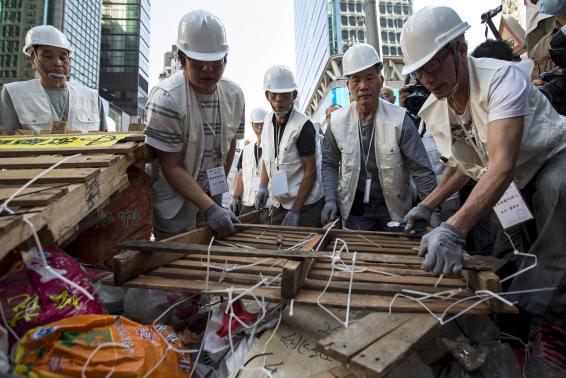
REUTERS/Tyrone Siu
(Reuters) – Hong Kong authorities encountered little resistance as they began clearing part of a pro-democracy protest camp in the bustling district of Mong Kok on Tuesday following a court order to reopen a road.
The gritty, working-class area across the harbor from the main protest site at Admiralty has been the scene of some of the most violent clashes during two months of pro-democracy demonstrations in the Chinese-ruled city.
Hundreds of police stood guard as authorities enforced the court order to reopen Argyle Street to free up traffic.
Workers in white helmets and vests moved wooden blockades from the road after demonstrators had earlier dismantled tents and packed up their belongings. The injunction was granted to a bus company which said the blockade had hurt business.
Some protesters heckled and held up yellow banners demanding Beijing allow full democracy in the global financial hub.
“Even if they clear this place, our will to fight for genuine universal suffrage hasn’t changed … it will only inspire people to think of other ways to continue this movement,” said protester Ken Chu, 27, wearing a bright yellow safety helmet and a gas mask.
Hong Kong leader Leung Chun-ying, who has called the protests illegal, urged activists to go home. Hundreds of protesters remain camped out along nearby Nathan Road, part of which local media said would be cleared later in the week.
The move in Mong Kok comes a week after the partial clearance of the largest protest site next to government buildings in Admiralty, enforcing another injunction order in a peaceful operation that left most of the main protest site intact.
Mong Kok has been a flashpoint for street brawls between students and mobs intent on breaking up the prolonged protests to demand free elections for the city’s next leader in 2017.
In August, Beijing offered Hong Kong people the chance to vote for their own leader in 2017, but said only two to three candidates could run after getting backing from a 1,200-person “nominating committee” stacked with Beijing loyalists.
More than 100,000 people took to the streets at the peak of the demonstrations but that number has dropped to a few hundred scattered in tents over the two main sites amid dwindling public support for the street protests.







